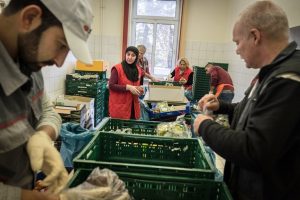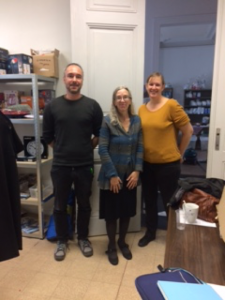|
|
Lessons for CED from Europe: Inclusive Communities and a New City-Run Food PantryBy Maureen BernerPublished October 17, 2017The photo was eerily familiar to anyone interested in CED. The headline from the New York Times article on September 20, just days before the German national election, read, “Merkel Says Germans ‘Never Had It Better.’ But Many Feel Left Behind.” The accompanying photo by Gordon Welters, shown here, features the Tafel food bank in Bremerhaven, a port city in northern Germany that is now struggling. The article described the contradictory economic situation in Germany, where standard economic measures are showing some positive signs while at the same time demand at relatively new community food banks, such as Tafel, is increasing. The situation described in the article resonates with some communities’ experience in their CED This fall I am working in Belgium as a visiting scholar with the University of Ghent. What lessons does central Belgium hold for North Carolina in terms of CED? Some innovative discussions on better understanding alignment and contradictions in economic growth and corresponding community development (or lack thereof) are coming from practitioners and researchers in Europe and Canada. A striking feature of many of the community development approaches here is that policies are framed by the concept of the basic right of citizens to social inclusion. A comprehensive description of the idea of social inclusion is beyond this post, but the basic idea is the ability of citizens to participate in the economic, social and cultural life of their community. Poverty, poor housing, unemployment, health barriers, lack of job opportunities and limited job skills lead to social exclusion. This is not just a vague concept but from interviews it is clearly incorporated into daily practice at the local level. Using the terms does not necessarily mean greater success in CED efforts – there is an affordable housing shortage that mirrors those in many North Carolina communities – but the conversation is framed in a different way. Those CED professionals who work on community capacity building will recognize this approach. The idea of social inclusion for community and economic development has been around for at least two decades. For example, eight years ago, efforts were made by international organizations such as the Organization for Economic Cooperation and Development (OECD) to improve local level capacity to promote social inclusion in its member countries, which include the U.S. and other major developed nations. It is part of U.N. long-term development goals. While it has been part of the CED landscape for a number of years, the idea of social inclusion as a framework for local CED officials In the U.S. appears to have gained significant momentum in the last two years. Two new reports from the Brookings Institution, Committing to Inclusive Growth and Opportunity for Growth demonstrate that the tension between economic growth and the need for gains to be distributed throughout communities for true community development to occur is now taking center stage. Brookings draws on a 6-month long project on the communities of Nashville, Indianapolis and San Diego to set forth lessons for local leaders nationwide. One of the opening graphs in the Opportunities for Growth report mirrors the conflicting economic story from Germany, but with different U.S. indicators – while overall income has grown, for many workers, it has been stagnant, and prospects for upward mobility have actually declined dramatically. The reports argue local leaders need to confront this tension head on. Even in European communities that have committed to inclusive growth, challenges are developing. Merelbeke, Belgium established its first town-run food pantry five years ago, seen here. It is in the exact center of town, but without a sign due to concerns by the local businesses. Clients enter at the rear and are greeted with a pleasant sitting room where they can have coffee and breakfast while their paperwork is reviewed – an effort in allow time for peer support and socialization. Only certain items are free – clients must spend their own money on other deeply discounted items. A diaper bank and relationship with a department store for new clothing has been very successful and valued by families. Clients are encouraged to volunteer at the pantry and are provided job training if they do so. Across all services, the social development of the client was paramount. The city employees in charge of the pantry hope to move to a new space soon because the number of clients is growing and it is seen as one of their most successful programs. The program is currently self-sustaining, apart from the city employee personnel costs. However, when asked about the ability to grow, the staff was unsure. Finances are tight and the employees at capacity. There is more in common in CED policies than one might think, which means there are more opportunities to explore and share positive lessons learned going forward.
|
Published October 17, 2017 By Maureen Berner
The photo was eerily familiar to anyone interested in CED. The headline from the New York Times article on September 20, just days before the German national election, read, “Merkel Says Germans ‘Never Had It Better.’ But Many Feel Left Behind.” The accompanying photo by Gordon Welters, shown here, features the Tafel food bank in Bremerhaven, a port city in northern Germany that is now struggling. The article described the contradictory economic situation in Germany, where standard economic measures are showing some positive signs while at the same time demand at relatively new community food banks, such as Tafel, is increasing.
The situation described in the article resonates with some communities’ experience in their CED  development efforts in North Carolina. North Carolina has seen an increase in poverty as measured by multiple indicators over the past two decades, even in years of economic growth and decreasing unemployment (see Documenting Poverty in North Carolina, 2016). One of those measures is demand at local food pantries in central and eastern North Carolina, which has seen a ten-fold increase since the mid-1990s.
development efforts in North Carolina. North Carolina has seen an increase in poverty as measured by multiple indicators over the past two decades, even in years of economic growth and decreasing unemployment (see Documenting Poverty in North Carolina, 2016). One of those measures is demand at local food pantries in central and eastern North Carolina, which has seen a ten-fold increase since the mid-1990s.
This fall I am working in Belgium as a visiting scholar with the University of Ghent. What lessons does central Belgium hold for North Carolina in terms of CED? Some innovative discussions on better understanding alignment and contradictions in economic growth and corresponding community development (or lack thereof) are coming from practitioners and researchers in Europe and Canada. A striking feature of many of the community development approaches here is that policies are framed by the concept of the basic right of citizens to social inclusion.
A comprehensive description of the idea of social inclusion is beyond this post, but the basic idea is the ability of citizens to participate in the economic, social and cultural life of their community. Poverty, poor housing, unemployment, health barriers, lack of job opportunities and limited job skills lead to social exclusion. This is not just a vague concept but from interviews it is clearly incorporated into daily practice at the local level. Using the terms does not necessarily mean greater success in CED efforts – there is an affordable housing shortage that mirrors those in many North Carolina communities – but the conversation is framed in a different way. Those CED professionals who work on community capacity building will recognize this approach.
The idea of social inclusion for community and economic development has been around for at least two decades. For example, eight years ago, efforts were made by international organizations such as the Organization for Economic Cooperation and Development (OECD) to improve local level capacity to promote social inclusion in its member countries, which include the U.S. and other major developed nations. It is part of U.N. long-term development goals.
While it has been part of the CED landscape for a number of years, the idea of social inclusion as a framework for local CED officials In the U.S. appears to have gained significant momentum in the last two years. Two new reports from the Brookings Institution, Committing to Inclusive Growth and Opportunity for Growth demonstrate that the tension between economic growth and the need for gains to be distributed throughout communities for true community development to occur is now taking center stage. Brookings draws on a 6-month long project on the communities of Nashville, Indianapolis and San Diego to set forth lessons for local leaders nationwide. One of the opening graphs in the Opportunities for Growth report mirrors the conflicting economic story from Germany, but with different U.S. indicators – while overall income has grown, for many workers, it has been stagnant, and prospects for upward mobility have actually declined dramatically. The reports argue local leaders need to confront this tension head on.
Even in European communities that have committed to inclusive growth, challenges are developing. Merelbeke, Belgium established its first town-run food pantry five years ago, seen here. It is in the exact center of town, but without a sign due to concerns by the local businesses. Clients enter at the rear and are greeted with a pleasant sitting room where they can have coffee and breakfast while their paperwork is reviewed – an effort in allow time for peer support and socialization. Only certain items are free – clients must spend their own money on other deeply discounted items. A diaper bank and relationship with a department store for new clothing has been very successful and valued by families. Clients are encouraged to volunteer at the pantry and are provided job training if they do so. Across all services, the social development of the client was paramount. 
The city employees in charge of the pantry hope to move to a new space soon because the number of clients is growing and it is seen as one of their most successful programs. The program is currently self-sustaining, apart from the city employee personnel costs. However, when asked about the ability to grow, the staff was unsure. Finances are tight and the employees at capacity. There is more in common in CED policies than one might think, which means there are more opportunities to explore and share positive lessons learned going forward.
Author(s)
Tagged Under
This blog post is published and posted online by the School of Government to address issues of interest to government officials. This blog post is for educational and informational Copyright ©️ 2009 to present School of Government at the University of North Carolina. All rights reserved. use and may be used for those purposes without permission by providing acknowledgment of its source. Use of this blog post for commercial purposes is prohibited. To browse a complete catalog of School of Government publications, please visit the School’s website at www.sog.unc.edu or contact the Bookstore, School of Government, CB# 3330 Knapp-Sanders Building, UNC Chapel Hill, Chapel Hill, NC 27599-3330; e-mail sales@sog.unc.edu; telephone 919.966.4119; or fax 919.962.2707.

